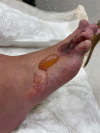Bullous Cutaneous Larva Migrans of the Foot
- PMID: 38412546
- PMCID: PMC10993841
- DOI: 10.4269/ajtmh.23-0750
Bullous Cutaneous Larva Migrans of the Foot
Figures




References
-
- Leung AKC, Barankin B, Hon KLE, 2017. Cutaneous larva migrans. Recent Pat Inflamm Allergy Drug Discov 11: 2–11. - PubMed
-
- Veraldi S, Çuka E, Pontini P, Vaira F, 2017. Bullous cutaneous larva migrans: Case series and review of atypical clinical presentations. G Ital Dermatol Venereol 152: 516–519. - PubMed
-
- Greaves D, Coggle S, Pollard C, Aliyu SH, Moore EM, 2013. Strongyloides stercoralis infection. BMJ 347: f4610. - PubMed
MeSH terms
LinkOut - more resources
Full Text Sources

